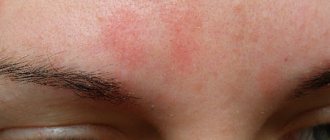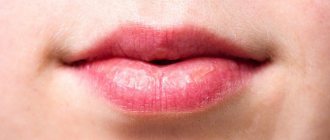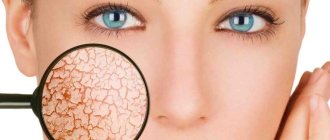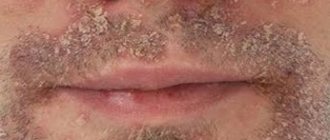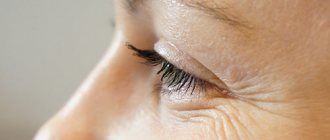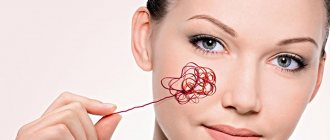Allergy on the face in the form of red spots is a common problem with which patients often turn to dermatologists. To clarify the exact cause of this condition most often requires time and a number of additional studies. To alleviate the condition of allergic dermatitis, modern antiallergic drugs are used, which include Cetrin.
Symptoms
It is quite easy to suspect an allergic reaction in yourself or your child. In addition to the presence of an allergic rash on the face, the following complaints are noted:
- Severe itching or burning;
- Dryness, flaking of the skin;
- Swelling of the eyelids, lips;
- lacrimation;
- Itching and redness of the eyes.
The rash itself may be in the form of red spots or blisters filled with transparent contents. Sometimes an allergic rash looks like small grouped dots that rise above the surface of the skin. If the rash appears after consuming any product, then symptoms may include nausea, vomiting, diarrhea, and abdominal pain1.
What else can phototherapy help with?
Pulses of light will help get rid of many aesthetic defects.
- Cuperosis;
- Photoaging;
- Uneven complexion;
- Wrinkles;
- Hyperpigmentation;
- Acne;
- Stagnant post-acne spots;
- Gravitational ptosis (sagging);
- Angiomas (red dots on the body);
- Rosacea.
You will be prescribed effective treatment for these and many other skin defects at the Elena Malysheva Medical Center. We employ the best specialists in various fields of medicine. Sign up for a consultation!
Causes
The main reasons for the appearance of red spots on the skin of the face:
- Direct skin contact with an allergen (cream, face mask, decorative cosmetics, soap, jewelry, etc.);
- Food allergies;
- Allergy to medications;
- Allergy to sun or cold;
- Eczema1.
To prevent the appearance of a rash in the future, it is necessary to accurately determine the cause of the allergy and eliminate contact with this substance.
What to do with local redness
Treatment of vascular pathologies and infectious diseases should be carried out under the supervision of a specialist on an outpatient basis. If the doctor determines that there are no medical problems, you can try to eliminate the defect yourself. Beauty salons offer several options for treating redness on the skin. Among the most effective:
- cryodestruction;
- ozone therapy;
- electrocoagulation;
- laser exposure;
- diathermocoagulation.
At home, whitening masks, lotions and compresses are effective.
The choice of method depends on the cause of the stains. Electrocoagulation and diathermocoagulation will help remove the effects of rosacea. The affected areas of the vessels are removed with an electrical impulse or a hair electrode. Cryodestruction allows you to quickly and painlessly get rid of angiomas. Sclerosing therapy can also help remove vascular tumors. Adhesive substances are injected into damaged vessels to promote the growth of collagen fibers. Red acne is treated with mechanical or chemical peels, as well as laser resurfacing.
Mechanical resurfacing will help deal with red spots on the skin.
Contact dermatitis
Contact dermatitis rashes are most often localized on the hands or face. An allergic reaction can be triggered by:
- Skin care products. It is important to pre-test creams, masks, lotions and other new products by applying a small amount of product to the inner surface of the forearm for 15-20 minutes.
- Decorative cosmetics. Contains a large number of coloring pigments, fragrances and preservatives. People with sensitive skin prone to dryness and irritation are more prone to allergic reactions.
- Plant pollen. When pollen from plants to which a person is allergic comes into contact with the skin, a rash, itching and other unpleasant symptoms may appear.
Red spots may appear either immediately after contact with the allergen or after some time (usually within 24-48 hours). If you find the cause of the allergy in time and stop using the inappropriate product, then no negative health consequences will be noted.
Medical correction of red moles
The doctor, after conducting an initial examination and the necessary diagnostic measures, will make a conclusion regarding the likelihood of malignancy of the red mole. Based on this diagnosis, a strategy for further therapeutic actions is developed. If a red mole does not pose an oncological threat and is located in a closed area of the body, its removal is not necessary.
In cases where the red nevus causes aesthetic or physiological discomfort to the patient, it can be removed using modern hardware techniques, the priority among which is laser destruction. This method of removing red moles guarantees painlessness and safety for the patient, and also has a low level of trauma.
Medical offers its patients the latest expert-class medical equipment that meets the most stringent European standards. Effective therapy, high-quality medical service and affordable prices are the main principles of our clinic.
Find out the cost of the procedure “Removal of tumors”
Allergies to foods and medications
Food allergies on the face are quite common, especially in children. The most allergenic foods are peanuts, eggs, seafood, citrus fruits, and dairy products. However, in the presence of individual intolerance, an allergy can develop to any other food product.
Main symptoms:
- blotchy rash on the face or body;
- Severe itching;
- Peeling of the skin;
- Nausea, vomiting;
- Stool disorders;
- Abdominal pain.
Another important problem is drug allergies. An allergic reaction may occur to a medicine in the form of a tablet, injection, or ointment. Allergies to antibiotics, antiseptics, and nonsteroidal anti-inflammatory drugs are common. The symptoms are the same as those of a food allergy. In severe cases, complications such as angioedema or anaphylactic shock may develop2. You need to know what drugs you are allergic to and warn doctors or medical staff about it.
Why do post-acne appear?
The unpleasant consequences of acne are always the result of incorrect or insufficient professional treatment. First of all, it is important to maintain hygiene: do not squeeze out the inflammatory element, do not touch it with dirty hands, follow all stages of skin cleansing and the recommendations of a dermatologist.
The causes of post-acne can be different: deep inflammation, long-term struggle with acne, incorrectly selected treatment. All this inevitably leaves unsightly marks, especially the regular squeezing out of inflammatory elements, which, as we said earlier, damages the capillaries.
Factors in the appearance of post-inflammatory erythema are divided according to the nature of the formation into pathological and physiological. The first include:
- infectious diseases or pathologies of the body;
- autoimmune diseases;
- thermal, radiation or chemical burn.
Physiological reasons include:
- physical injury or intense massage;
- certain medications taken in large doses;
- long exposure to the open sun without proper protection.
Mild erythema goes away in a couple of days; in more serious cases, recovery may take several weeks. The speed depends on the individual characteristics of the body: cell regeneration (ability to renew), hormonal levels, deficiency or excess of vitamins, as well as on the cosmetics used to combat post-acne.
The causes of post-inflammatory pigmentation are still not fully understood, but scientists have identified several factors that influence their development. These include:
- stress;
- hormonal disorders;
- infection;
- diet;
- genetic predisposition.
Some experts believe that exposure to the sun does not affect the appearance of post-inflammatory pigmentation, but there is no evidence of this yet.
Allergy to sun or cold
Natural factors can also cause the development of allergic reactions. Photoallergy or sun allergy most often occurs in the warm season - from late spring to early autumn. Sometimes an allergic rash is confused with sunburn, but the allergic nature of the disease is characterized by severe itching, the appearance of small, white pustules, and spotty red rashes even after a short stay in the open sun. In such cases, you need to apply sunscreen, protect exposed skin with clothing made from natural fabrics, and wear a hat3.
Allergy to cold or cold urticaria also occurs. During the cold season, red itchy rashes, peeling, and a feeling of tightness appear on the skin of the face and hands. Symptoms may persist for several hours or several days after exposure to the cold. Typically, allergies develop at temperatures from 10 degrees below zero, but it also happens at temperatures close to zero.
Causes of red moles on the body
By its nature, a red mole is a cluster of vessels and capillaries, which normally perform the function of oxygen and nutritional supply to the epidermal structures. With the development of any internal pathological process or under the influence of exogenous factors, small vessels can connect, forming a kind of bundle, which in medicine is often called an angioma.
When asked by a patient regarding small red moles, “What is this?”, the specialist will most often answer – angioma. Typically, these pigmented formations are formed during the period of active growth of the body, that is, in early childhood, which is associated with a serious transformation of the human vascular system at this age.
A distinctive feature of red pigmented nevi is the loss of color intensity of the formation when pressing on it, which is associated with a vascular reaction. In addition, red moles normally do not hurt or itch, and do not change their shape and size over time.
The following etiotropic factors may be the causes of angiomas in adult patients:
- Excessive sun exposure (excessive ultraviolet radiation);
- Hormonal imbalance (puberty, pregnancy, menopause, etc.);
- Pathologies of the gastrointestinal tract, especially the pancreas;
- Injuries and mechanical damage to the epidermal integument;
- Diseases of the cardiovascular system;
- Violation of the formation or destruction of pigmented cells.
Today, doctors do not give a clear answer regarding the causes of red moles on the body, however, the factors listed above can become a provoking condition for their appearance.
Eczema
Eczema is an inflammatory skin disease that tends to be chronic and relapsing. Often the symptoms of eczema are confused with allergic reactions, since the rashes can be similar in appearance. Eczema is characterized by the appearance of bright red spots and swelling of the skin. Grouped bubbles with transparent contents appear on a red background, after which crusts form.
The occurrence of the disease is associated with mechanical damage to the skin, microbial or fungal infection, and occupational hazards. Complex immune reactions characteristic of allergies also take part in the development of pathology.
Types of red moles
The appearance of red moles on the body can be accompanied by various visual characteristics of the defect. Such epidermal formations can be either flat, forming in the deep dermal layers, or have a superficial nature, protruding above the skin. Moreover, according to the nature of the visual picture, all angiomas are usually divided into two groups:
- Spot. The pigmented area has clear red borders and is a point at which a collection of vessels and capillaries is concentrated. Often, punctate angiomas are multiple in nature, manifesting themselves in the form of specific “rashes” on the patient’s skin.
- Star-shaped. Such moles are a collection of tiny thin vessels that are visible through the epidermis and converge at a central point, forming a kind of star. These structures are also associated with diseases such as rosacea.
In addition, a separate group includes especially large red moles on the body - hemangiomas, which usually significantly spoil the patient’s appearance and require cosmetic correction.
Treatment
Treatment for facial allergies must include a safe and effective antihistamine3. Cetrin is widely used for seasonal allergies and various forms of allergic dermatitis. The main active ingredient of the drug is cetirizine hydrochloride, which is a histamine antagonist. The advantages of the drug include:
- Quick effect. Onset of action 20 minutes after administration.
- Duration of action. The drug is taken once a day and is effective for 24 hours.
- Good tolerance. Cetrin is well tolerated by patients and causes less drowsiness than first-generation drugs1.
The drug helps eliminate itching, swelling, and redness of the skin. Available in tablet form, approved for use in children over 6 years of age. If you suspect an allergic rash, taking Cetrin is a simple, safe way to make you feel better before you can see a doctor.
Preventive measures
A mandatory point of treatment is a balanced diet. It is especially important for people suffering from allergies or congenital vascular weakness. Fatty and sweet dishes, hot seasonings, canned food, smoked meats and sausages are removed from the menu. It is necessary to completely eliminate alcohol and smoking; nicotine, tobacco tar and ethyl alcohol destroy the weak walls of blood vessels. The diet includes fresh vegetables and fruits, dairy products, animal proteins (fish, poultry). These products strengthen capillaries and stimulate the production of natural collagen.
It is important to protect your face from aggressive sun rays. Before going outside, apply a cream, gel or spray with a high SPF to your face. Properly selected decorative cosmetics can also hide redness. A foundation without mineral oils covers imperfections well and does not cause irritation. It is important to avoid contrasting procedures: steam baths, ice compresses. They have a destructive effect on fragile capillaries and increase the risk of their rupture.
Color of the skin
Look to see if any changes have appeared on your face, such as swelling or hyperpigmentation. Skin color is very important in assessing health.
Straw color.
If you have a straw complexion, you need to do a biochemical blood test. The symptom often signals a vitamin B12 deficiency.
B12 deficiency is obvious if a set of symptoms is present:
- lips have a straw tint;
- epigastric pain occurs;
- there is a burning sensation of the tongue;
- depression is present.
B12 deficiency can be expressed not only by a discolored complexion, but also by other symptoms.
Gray complexion.
A grayish tint to the face appears in people with chronic lung disease and in smokers. However, in the latter, chronic lung pathology occurs most often.
Smokers should regularly undergo spirometry testing to diagnose the disease. And if your skin color has taken on a gray tint, you need to get checked immediately.
Paleness of the skin.
Pale facial skin indicates anemia or low blood pressure. The condition is especially noticeable with temporary drops in pressure.
Redness.
If the face turns red, this may indicate pressure surges. When it comes to experiencing strong emotions, the problem is temporary and does not pose a danger.
With constant redness of the face with simultaneous redness of the conjunctiva, a comprehensive diagnosis is required, including a set of specialized cardiological studies. Such symptoms are caused by vascular diseases and heart problems.
But redness in the form of symmetrical spots on the nose and cheeks, resembling the shape of a butterfly, is one of the initial manifestations of lupus, one of the most dangerous and formidable kidney diseases.
Hyperpigmentation spots
. If the spots are brown and appear randomly, mainly on the forehead and cheeks, these are rather symptoms of impaired liver function. A blood test should be done for so-called liver tests.
In this case, it is recommended to exclude from the diet:
- coffee and alcohol;
- fats;
- spicy spices;
- foods with saturated and trans fats.
If the spots are symmetrical and appear on the upper lip, then the condition often indicates hormonal disorders.
How to get rid of acne spots using cosmetology
Excessive spotting does not affect a person’s well-being, but his appearance and emotional state noticeably suffer from such acquisitions. It is logical that the first specialist who is contacted to remove post-acne and stagnant spots is a cosmetologist/dermatologist. In what ways does it help with erythema:
- laser exposure to capillaries;
- gels and ointments that narrow the walls of blood vessels;
- creams, masks and all kinds of peelings.
Experts in the field of cosmetology believe that erythema can disappear on its own in six months to a year. But in the case of post-inflammatory pigmentation, it is much more difficult to get rid of spots. Here are the popular methods that cosmetologists use in their practice:
- Microdermabrasion is the “filing off” of the stratum corneum of the skin. To completely remove post-acne pigmentation, 2-3 sessions are required, and the skin recovers within a month. During this time, you should avoid direct sunlight and refrain from going to the solarium, swimming pool and sauna.
- Mesotherapy with vitamins. It comes in the form of injections with a concentrate of vitamins, nucleic acids, amino acids, and proteins. It can also be applied to the skin with a vitamin cocktail, which is delivered to the deep layers of the epidermis using a laser device or microneedling (multiple skin punctures).
- Photothermolysis. The procedure involves burning out the upper layer of the epidermis, and the thermal effect provokes increased cell regeneration.
- Ozone therapy. Removing pigment spots with ozone. There are three types: meso-ozone therapy, ozone tonic and injections. The first is treating clean skin with a roller with an oxygen-ozone composition. Ozone tonic - rubbing the skin with an ozone cocktail, especially recommended against pigmented brown spots. With ozone injections, an ozone cocktail is injected under the skin, and the injection site visibly swells. Using massage movements, the substance is evenly distributed throughout the problem area.
- Laser facial resurfacing. Requires lengthy preparation: avoid ultraviolet radiation a month before the procedure, start using sunscreen 14 days before, undergo a medical examination, and take urine and blood tests. Acne spots on the face will go away only after a course of procedures, which lasts from 3 to 10 sessions. A rather traumatic method that requires a long period of rehabilitation.
- Dermabrasion. Mechanical damage to the stratum corneum of the skin. It can be superficial, deep and medium. Superficial dermabrasion touches the layers of skin up to the basal membrane, medium touches only the basal level, and deep penetrates to the papillary layer of the epidermis. Painful! There are contraindications.
- Chemical peeling. Organic acids are used that cause a controlled burn and subsequent death of the top layer of skin.
Each of the listed procedures requires a mandatory recovery period and is contraindicated during pregnancy and lactation!
Facial swelling
A slight swelling of the facial tissues, which persists constantly, most often indicates the initial stage of an endocrine disease - hypothyroidism. Pigmentation quickly disappears after taking thyroid hormone - thyroxine.
Mild and persistent swelling of the face, which is accompanied by shortness of breath and swelling of the legs, usually in the ankles, as well as frequent getting up at night to go to the toilet, indicates circulatory failure and poor heart function.
When swelling of the face is accompanied by pallor, and visits to the toilet are very frequent, but urination is scanty, kidney disease can be suspected.
It is very dangerous when fluid accumulates only in the upper lip. If the swelling is accompanied by a feeling of tightness in the chest, difficulty breathing, then this is an allergic reaction - Quincke's edema!
The condition can become a serious threat to life. In this case, an ambulance is needed.
How to Get Rid of Acne Spots with Physiotherapy
To increase the effectiveness of cosmetics, physiotherapy is used - in the case of post-acne spots, we recommend using phonophoresis or microcurrents for a more pronounced result.
Today we’ll talk about phonophoresis. With this procedure, the beneficial substances of the gel or cream are delivered to the deep layers of the skin thanks to the influence of ultrasound.
The transferred components accumulate in the form of a medicinal depot in the skin and subcutaneous fat, significantly increasing the effectiveness of the drug and the time of its action. This is why the effect of physiotherapy lasts longer than a course of skin applications.
To conduct a session, you need a medium - a gel or cream with active ingredients that need to nourish the epidermal cells and eliminate the deformed substrate. The cosmetic product is applied only to previously cleansed skin! Since air does not carry ultrasound, you should press the emitter head tightly against the gel/cream application at the site of the problem area.
Next, the required ultrasound frequency is set - the lower the number, the stronger the effect on the body. Thus, at a frequency of 800–1000 kHz, ultrasound penetrates 5–6 cm, and at 2400 kHz, 1–2 cm. In the case of acne spots, a greater depth is not needed to solve a problem not of a medical, but of a cosmetic nature, deeper than 2 cm not worth influencing.
One session of phonophoresis takes 10–15 minutes, depending on the specific case and the severity of pigmentation. To remove red spots from acne, you need to complete a course of 8–15 procedures at intervals of a day or two.

